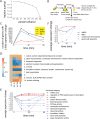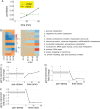Regulatory and evolutionary adaptation of yeast to acute lethal ethanol stress
- PMID: 33170850
- PMCID: PMC7654773
- DOI: 10.1371/journal.pone.0239528
Regulatory and evolutionary adaptation of yeast to acute lethal ethanol stress
Abstract
The yeast Saccharomyces cerevisiae has been the subject of many studies aimed at understanding mechanisms of adaptation to environmental stresses. Most of these studies have focused on adaptation to sub-lethal stresses, upon which a stereotypic transcriptional program called the environmental stress response (ESR) is activated. However, the genetic and regulatory factors that underlie the adaptation and survival of yeast cells to stresses that cross the lethality threshold have not been systematically studied. Here, we utilized a combination of gene expression profiling, deletion-library fitness profiling, and experimental evolution to systematically explore adaptation of S. cerevisiae to acute exposure to threshold lethal ethanol concentrations-a stress with important biotechnological implications. We found that yeast cells activate a rapid transcriptional reprogramming process that is likely adaptive in terms of post-stress survival. We also utilized repeated cycles of lethal ethanol exposure to evolve yeast strains with substantially higher ethanol tolerance and survival. Importantly, these strains displayed bulk growth-rates that were indistinguishable from the parental wild-type strain. Remarkably, these hyper-ethanol tolerant strains had reprogrammed their pre-stress gene expression states to match the likely adaptive post-stress response in the wild-type strain. Our studies reveal critical determinants of yeast survival to lethal ethanol stress and highlight potentially general principles that may underlie evolutionary adaptation to lethal stresses in general.
Conflict of interest statement
The authors have declared that no competing interests exist.
Figures




References
Publication types
MeSH terms
Substances
Grants and funding
LinkOut - more resources
Full Text Sources
Molecular Biology Databases
Miscellaneous

